Video of the Week:
Pruning Fruit Trees
Fruit:
Frost Tolerance of Apricots and Peaches
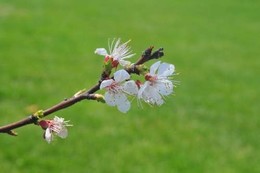
Apricot
Stage 10% Kill (°F) 90% Kill (°F)
First white 24 14
First Bloom 25 19
Full Bloom 27 22
In the Shuck 27 24
Green Fruit 28 25
Peach
Stage 10% Kill (°F) 90% Kill (°F)
Swollen bud 18 2
Half-inch green 23 5
Pink 25 18
Bloom 27 24
Petal fall 28 25
Fruit set 28 25
To check for low temperature injury to fruit buds or blossoms, use a sharp knife and cut them in half longitudinally (from top to bottom). If the tiny seed in the center is white to cream color no damage has been done. But if the seed in several buds or blossoms is dark brown or black, it has been killed.It is possible to give some protection to blossoms from freezing by covering the tree with a bed spread, blanket or similar fabric. Old-fashioned Christmas lights distributed around the tree will help to give additional protection. The newer, smaller Christmas lights do not give off enough heat and are not recommended. Of course the practicality of this method of protection depends upon the size and number of trees.
Sprinkling the tree with water throughout the freezing period can also protect the blossoms. Sprinklers should be started before the temperature drops to freezing to be sure ice does not block the garden hose or water line. Continue until the temperature warms. With this protection method, there is the potential of creating an ice storm. If temperatures remain below freezing for several hours, ice will accumulate on the branches and limbs. The weight from the ice may cause branches and limbs to break causing severe, and possibly permanent, damage to the tree structure. Also, if water drainage from the soil is slow and the water displaces oxygen from the roots, damage to trees may result. (Ward Upham)
Vegetables:
Controlling Weeds in Home Garden Asparagus Beds
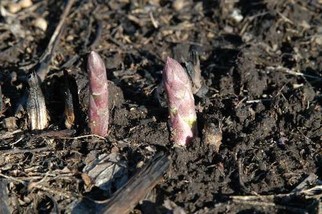
Herbicides can be used before asparagus emerges. Glyphosate (Roundup, Killzall) will kill weeds that are actively growing, and the preemergence herbicide trifluralin can be used to kill weed seeds as they germinate. Trifluralin is found in several products, but not all of them list asparagus on the label. Those that do have asparagus on the label include Miracle-Gro Weed Preventer Granules and Monterey Vegetable and Ornamental Weeder. Mulch can also be used to keep weeds from invading.
No herbicides can be used during harvest. The end of harvest presents another opportunity. Remove all fern and spears and apply Roundup to control virtually all of the weeds present. Past the harvest season and after regrowth of the asparagus, options are limited. Products that contain sethoxydim can be applied to asparagus to kill grassy weeds. Sethoxydim has no effect on broadleaves including asparagus. Two sethoxydim products available to homeowners and
labeled for asparagus are Monterey Grass Getter and Hi-Yield Grass Killer. With broadleaves, the only option is to pull them and look forward to next year. (Ward Upham)
Remove Fern and Fertilize Aspargus
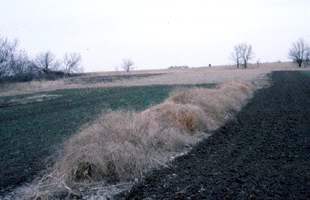
Also, asparagus benefits from a fertilizer application early spring. Fertilize according to a soil test or add 1 to 2 pounds of a 10-20-10 fertilizer per 20 feet of row before growth starts. If a soil test shows that only nitrogen is needed, apply 1 pound of a 16-0-0 product or ½ pound of a 30-4-5, 27-3-3 or similar fertilizer per 20 feet of row. Incorporate lightly with a tiller or rake in fertilizer before spears emerge. Fertilize again at the same rate after the last harvest. (Ward Upham)
Flowers:
Preventing Weeds in Flower Beds
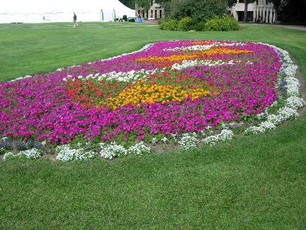
Preemergence herbicides do not keep the weed seed from germinating but kill the young plant as it starts to grow. It is necessary to water these products in (1/4 inch of water) so that the young weed root will contact the herbicide. Be aware that most of these products are more effective on grassy weeds such as crabgrass rather than broadleaves such as dandelions or spurge.
These herbicides often have no effect on existing plants, so they must be applied before the weed seed germinates. Additionally, preventers do not last forever once applied to the soil. Microorganisms and natural processes begin to gradually break them down soon after they are applied. However, all should last long enough so that you get canopy cover before the herbicide wears off.
Read the label for information on when to apply the product. Also, be sure the ornamental plants within the bed area are on the label before purchasing the product. See below for products we can use.
Dimension (dithopyr)
- Hi-Yield Turf & Ornamental Weed and Grass Stopper
- Bonide Crabgrass & Weed Preventer
Treflan (trifluralin)
- Hi-Yield Herbicide Granules Weed and Grass Preventer
- Miracle Gro Garden Weed Preventer
- Preen Weed Preventer
(Ward Upham)
Turfgrass:
Managing Turf in the Shade
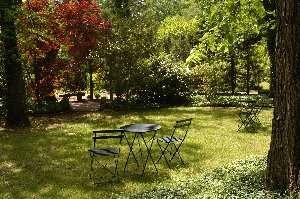
Remember the problem is lack of light, not lack of fertility. Too much nitrogen in the spring causes the plant to grow faster and may result in weak plants. The nitrogen rate for shaded grass should be cut back to at least half of that for grass in full sun. Late fall fertilization after tree leaves have fallen, on the other hand, is important for shaded cool-season turfgrasses and should be applied at a full rate. Irrigate infrequently but deeply. Light, frequent irrigation may encourage tree feeder-roots to stay near the surface, which increases competition between the trees and the turf. Restrict traffic in the shade.
Many times, the best choice for shaded areas is switch from a turfgrass to a more shade-tolerant plant. For example, English ivy and periwinkle (Vinca minor) are much more shade tolerant than any turfgrass adapted to our area. Another option is simply to mulch the area where turf doesn’t grow well. The trees will love the cool, moist soil and the absence of competition. (Ward Upham)
Ornamentals:
Brown Coloration on Junipers
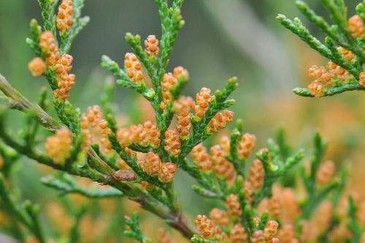
Most junipers are dioecious, meaning they have both male and female plants. About half the junipers (the males) will have this coloration. The female flowers are much less obvious. If you have clients who are concerned about this brown coloration, have them check the plants to ensure the male flowers are the cause. If they are, assure them that this is normal and will fade with time. (Ward Upham)
Miscellaneous:
Adding Organic Matter in the Spring
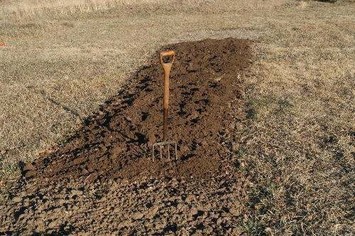
To determine if a soil is too wet to work, grab a handful and squeeze. If water comes out, it is much too wet. Even if no water drips out, it still may not be dry enough to work. Push a finger into the soil you squeezed. If it crumbles, it is dry enough, but if your finger just leaves an indentation, more time is needed. Be sure to take your handfuls of soil from the depth you plan to work the soil because deeper soils may contain more moisture than the surface. (Ward Upham)
Contributors: Ward Upham, Extension Associate
 RSS Feed
RSS Feed
